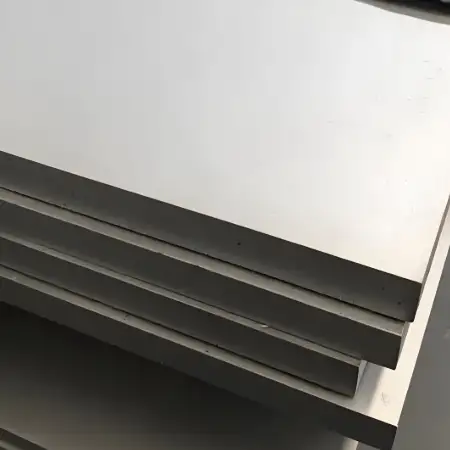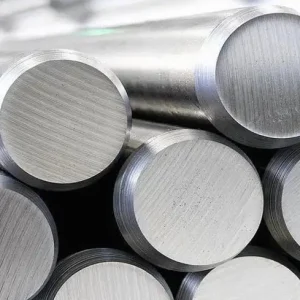Inconel 600 plate (UNS N06600) is a robust nickel-chromium-iron alloy chosen when sustained high-temperature strength and resistance to oxidation, chloride stress-corrosion and many corrosive media are required; for most industrial plate uses it offers a blend of good fabricability, weldability, and stable performance from cryogenic service up to roughly 1,350–1,410 °C (2,470–2,575 °F), making it a preferred plate material for chemical processing, furnace and heat-treatment hardware, nuclear and power components, and demanding petrochemical duty.
What is Inconel 600 plate?
Inconel 600 is a solid-solution nickel-based alloy with chromium and iron in significant amounts. When supplied as plate or sheet (commonly under ASTM B168 / ASME SB168 or equivalent mill specs), it is furnished in the annealed/soft condition for formability and in tight chemical limits to support consistent mechanical performance at elevated temperature. It is not age-hardenable; increases in strength come from cold working. Typical industry designation is UNS N06600 (W.Nr. 2.4816).
Quick technical summary
-
UNS / Trade names: UNS N06600, Inconel® 600 (Special Metals trademark), Alloy 600.
-
Standards: ASTM B168 / ASME SB168 for plate/sheet; mill test certificates per ASTM/ASME are common.
-
Service temperature window: Cryogenic up to ≈1350–1410 °C (practical service typically quoted to ~1093 °C / 2000 °F depending on application).
-
Density: ≈ 8.47 g/cm³ (0.306 lb/in³). Use 8.47 g/cm³ when calculating weight for plate.
-
Key strengths: Oxidation resistance, chloride stress-corrosion resistance vs. many steels, good weldability and workability.
Chemical composition
The numbers below are standard limiting composition ranges used by mills for UNS N06600 / Inconel 600 plate (always confirm with the mill test certificate / MTC on order).
| Element | Typical limit / range (wt%) |
|---|---|
| Nickel (Ni) | ≥ 72.0 (balance) |
| Chromium (Cr) | 14.0 – 17.0 |
| Iron (Fe) | 6.0 – 10.0 |
| Carbon (C) | ≤ 0.15 |
| Manganese (Mn) | ≤ 1.00 |
| Silicon (Si) | ≤ 0.50 |
| Copper (Cu) | ≤ 0.50 |
| Sulfur (S) | ≤ 0.015 |
| Phosphorus (P) | ≤ 0.015 |
| Aluminum (Al) | ≤ 0.30 |
| Titanium (Ti) | ≤ 0.30 |
| Boron (B) | ≤ 0.006 |
(Source: Special Metals technical bulletin and multiple mill datasheets consolidating ASTM limits.)
Practical note: Buyers who need nuclear-grade, high-purity or low-impurity material should request the exact certified composition and any additional trace element limits (e.g., for applications sensitive to cobalt or copper).
Mechanical & physical properties
Below are representative properties for annealed Inconel 600 plate. Mill certificates will show the exact guaranteed minima.
| Property | Typical / typical annealed |
|---|---|
| Density | 8.47 g/cm³ (0.306 lb/in³) |
| Ultimate tensile strength (UTS) | ≈ 655 MPa (≈ 95,000 psi) (typical room temp) |
| Yield strength (0.2% offset) | ≈ 240–310 MPa (35–45 ksi) depending on spec/condition |
| Elongation (in 50 mm) | ≈ 35–55% (annealed) |
| Hardness (annealed) | ~ Rockwell B / Varies; cold work increases hardness |
| Modulus of elasticity | ≈ 214 GPa (31.1 x10³ ksi) |
| Melting range | ≈ 1354 – 1413 °C (2470 – 2575 °F) |
Design tip: Because Inconel 600 does not precipitation-harden, designers seeking higher static strength at temperature often choose other nickel alloys (e.g., 625, 718) — specify exactly the temperature and environment to match alloy performance.
Common sizes and weight examples
Plate widths, lengths and thicknesses vary by mill and country: standard mill stock widths run up to ~2.5 m and lengths to 6 m or longer for special orders; thicknesses commonly 2.5 mm → 100 mm (and thicker on request). ASTM B168 lists general size coverage for plate and sheet.
I prepared a practical size→weight table (using density = 8.47 g/cm³). The interactive table was generated and displayed for you (title: Inconel 600 Plate Size & Weight). Example rows from that table (weights rounded):
-
1,000 × 2,000 mm plate:
-
2 mm → 33.880 kg (≈ 74.7 lb)
-
6 mm → 101.640 kg (≈ 224.1 lb)
-
25 mm → 423.500 kg (≈ 933.7 lb)
-
-
1,500 × 3,000 mm plate:
-
2 mm → 76.230 kg
-
10 mm → 381.150 kg
-
-
2,000 × 6,000 mm plate:
-
2 mm → 203.280 kg
-
50 mm → 4,201.460 kg
-
(Full interactive table was shown above for quick quoting and planning.)
How weights were calculated: Volume (m³) × density (kg/m³), with density = 8.47 g/cm³ = 8,470 kg/m³. Use these figures when estimating shipping and handling costs.
What is Inconel 600 used for?
-
Heat-treatment & furnace components: retorts, muffles, trays and baskets due to oxidation resistance at high T.
-
Chemical processing: components where reducing/oxidizing cycles and acids exist; good for certain caustic environments.
-
Power / nuclear: some steam generator and reactor secondary circuit applications where high-purity water compatibility is needed — check nuclear grade variants and certifications.
-
Petrochemical & gas processing: valves, heat exchangers, flanges when chloride or sulfurous environments exist.
-
Aerospace / engine parts: seals, exhaust liners, components exposed to high heat (when plate is used for structural or casing items).
Note to designers: For concentrated chloride environments at moderate temperatures some other nickel alloys may offer superior stress-corrosion resistance — run a corrosion engineering check for service chemistry and temperature.
Inconel 600 plate equivalents and cross-references
-
UNS: N06600 (primary).
-
Werkstoff / EN (approx): 2.4816 commonly referenced in European mill lists.
-
ASTM / ASME: ASTM B168 / ASME SB168 for plate & sheet (see standard listing).
-
Common cross-grade notes: Inconel 600 vs 601 vs 625 — 600 has higher Ni and less Mo than 625; 625/718 are chosen when higher yield strength, creep resistance, or improved aqueous corrosion is required. Evaluate application chemistry before cross-referencing.
Manufacturing, fabrication & welding notes
-
Forming: Plate is typically supplied annealed for forming. Cold working increases strength.
-
Welding: Inconel 600 welds well with matching nickel filler metals (e.g., ERNiCr-x family) — preheat is usually not required for thin plate, but follow procedure qualification and consult the filler supplier. Post weld heat treatment is application-dependent.
-
Heat treatment: Alloy does not age-harden; solution annealing (where applicable) is used to restore ductility after heavy cold work.
-
Surface finish & machining: Machinability is fair — cutting tools and speeds differ from steels; coolant and chip management matter. Refer to nickel alloy machining guides for feeds/speeds.
Global price comparison — USA / Europe / China (2025)
Important: prices for nickel alloys vary widely with thickness, plate form (sheet/plate/plate cut), certification (mill test certs, pedigree, traceability), quantity, alloy-surcharge (commodity nickel), and shipping/currency. Below are market-observed ranges for Inconel 600 plate in 2025 typical trade lots; treat them as indicative and confirm with supplier quotes.
Representative market ranges (2025) — typical retail/wholesale ranges:
| Region | Typical 2025 range (USD per kg) | Notes / source |
|---|---|---|
| USA | $18 – $48 / kg | U.S. suppliers and small-volume distributors show higher premiums; alloy surcharge data and distributor pricing contribute. |
| Europe | $16 – $42 / kg | European warehouse stock and mill runs; premiums for certified aerospace/nuclear material drive top end. (sources: European suppliers & marketplace listings). |
| China / Asia | $12 – $25 / kg (factory direct ranges) | China factory offers and marketplace listings often sit at lower unit price for bulk plate but check MTC, heat treatment and export packing. |
Sources / evidence: marketplace listings and manufacturer price pages show per-kg ranges for Inconel plate in the $12–$48/kg band depending on region and quantity; surcharge indices also add $/lb adjustments monthly. Use the cited market pages and the alloy-surcharge bulletin to refine a locked quote.
Buying tips to lower landed cost:
-
Buy full plates / pallets rather than cut-to-size retail pieces.
-
Accept factory MTC only (instead of multiple third-party inspections) when trusting reputable mills to reduce paperwork cost — but for critical work always demand required certifications.
-
Consolidate logistics: container shipping for large orders usually beats air or LCL.
-
Ask for alloy surcharge breakdown — many mills add a variable surcharge tied to nickel market. Compare supplier surcharge policies.
How MWalloys supplies Inconel 600 plate
MWAlloys provides Inconel 600 plate with the following buyer-focused commitments (tailorable to your project needs):
-
Factory direct pricing: 100% factory price advantage on qualifying orders — direct mill relationships, which typically lowers per-kg cost vs. local distributors.
-
Stock availability & fast delivery: MWalloys keeps a rolling inventory for common plate sizes and thicknesses; when stocked items match the order we dispatch with expedited logistics to major ports.
-
Certificates: Mill Test Certificates (MTCs) supplied with every shipment; optional third-party inspection or additional certification packages available on request.
-
Cutting & finishing: Plate cutting, edge conditioning and protective packing can be provided to buyer specifications.
-
Order minimums & MOQ: Factory MOQ varies by size and cut; contact the sales team with required dimensions, quantity and certification level for a firm quote.
FAQs
-
Is Inconel 600 magnetic?
No, alloy 600 is essentially non-magnetic in the annealed condition, though heavy cold work can induce slight magnetic response. -
What certificate should I require?
Always ask for an MTC (mill test certificate) showing UNS N06600 chemistry and mechanicals to ASTM B168 / ASME SB168, plus heat number traceability. -
Can Inconel 600 be welded to stainless steel?
Yes, but use compatible nickel-based filler materials and follow qualified WPS. Avoid mixing without qualification on critical parts. -
How do plate thickness and fabrication change price?
Thicker plate and full-certified aerospace/nuclear grades raise cost significantly; cutting, testing, and heat treatment also add to unit price. -
Is Inconel 600 better than 625?
They serve different needs: 600 has excellent oxidation resistance and chloride SCC resistance; 625 offers higher strength and superior resistance to many aqueous corrosion environments due to Mo and Nb. -
What lead time should I expect?
For stocked sizes: days to a couple of weeks. For non-stock mill runs or certified lots: several weeks to months. (Confirm with supplier.) -
How do I calculate plate weight?
Weight (kg) = width (m) × length (m) × thickness (m) × density (8,470 kg/m³). Example table has common sizes. -
Can Inconel 600 be used in seawater?
It has reasonable resistance to some seawater exposures but may not be optimal for certain chloride-rich, high-velocity conditions; pick nickel alloys engineered for seawater if conditions demand. -
What tests should I require for critical parts?
Beyond MTC: mechanical test report, PMI (positive material identification), non-destructive testing (UT, RT) where specified, and any traceability/nuclear requirements. -
How variable are prices in 2025?
Prices change by region, quantity and monthly alloy surcharges tied to nickel markets; ranges in section 9 reflect typical 2025 observed bands. Always get a dated written quote.
Authoritative references
- Special Metals — INCONEL® Alloy 600 Technical Bulletin (UNS N06600)
- Nickel Institute — Properties of Some Metals and Alloys (Inconel 600 summary)
- MatWeb / ASM — INCONEL® Alloy 600 material data sheet
- ASTM B168 / ASME SB168 — Standard Specification for Nickel-Chromium-Iron Alloy Plate, Sheet and Strip (ASTM.org)





